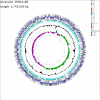Complete genome and comparative analysis of the chemolithoautotrophic bacterium Oligotropha carboxidovorans OM5
- PMID: 20863402
- PMCID: PMC3091675
- DOI: 10.1186/1471-2164-11-511
Complete genome and comparative analysis of the chemolithoautotrophic bacterium Oligotropha carboxidovorans OM5
Abstract
Background: Oligotropha carboxidovorans OM5 T. (DSM 1227, ATCC 49405) is a chemolithoautotrophic bacterium capable of utilizing CO (carbon monoxide) and fixing CO2 (carbon dioxide). We previously published the draft genome of this organism and recently submitted the complete genome sequence to GenBank.
Results: The genome sequence of the chemolithoautotrophic bacterium Oligotropha carboxidovorans OM5 consists of a 3.74-Mb chromosome and a 133-kb megaplasmid that contains the genes responsible for utilization of carbon monoxide, carbon dioxide, and hydrogen. To our knowledge, this strain is the first one to be sequenced in the genus Oligotropha, the closest fully sequenced relatives being Bradyrhizobium sp. BTAi and USDA110 and Nitrobacter hamburgiensis X14. Analysis of the O. carboxidovorans genome reveals potential links between plasmid-encoded chemolithoautotrophy and chromosomally-encoded lipid metabolism. Comparative analysis of O. carboxidovorans with closely related species revealed differences in metabolic pathways, particularly in carbohydrate and lipid metabolism, as well as transport pathways.
Conclusion: Oligotropha, Bradyrhizobium sp and Nitrobacter hamburgiensis X14 are phylogenetically proximal. Although there is significant conservation of genome organization between the species, there are major differences in many metabolic pathways that reflect the adaptive strategies unique to each species.
Figures


References
-
- Pelzmann A, Ferner M, Gnida M, Meyer-Klaucke W, Maisel T, Meyer O. The CoxD Protein of Oligotropha carboxidovorans Is a Predicted AAA+ ATPase Chaperone Involved in the Biogenesis of the CO Dehydrogenase [CuSMoO2] Cluster. The Journal of biological chemistry. 2009;284(14):9578–9586. doi: 10.1074/jbc.M805354200. - DOI - PMC - PubMed
-
- Bergey DH, Holt JG. Bergey's manual of determinative bacteriology. 9. Baltimore: Williams & Wilkins; 1994.
-
- Fuhrmann S, Ferner M, Jeffke T, Henne A, Gottschalk G, Meyer O. Complete nucleotide sequence of the circular megaplasmid pHCG3 of Oligotropha carboxidovorans: function in the chemolithoautotrophic utilization of CO, H(2) and CO(2) Gene. 2003;322:67–75. doi: 10.1016/j.gene.2003.08.027. - DOI - PubMed
-
- Guerrero R. Bergey's manuals and the classification of prokaryotes. Int Microbiol. 2001;4(2):103–109. - PubMed
Publication types
MeSH terms
Substances
LinkOut - more resources
Full Text Sources
Molecular Biology Databases
Miscellaneous

